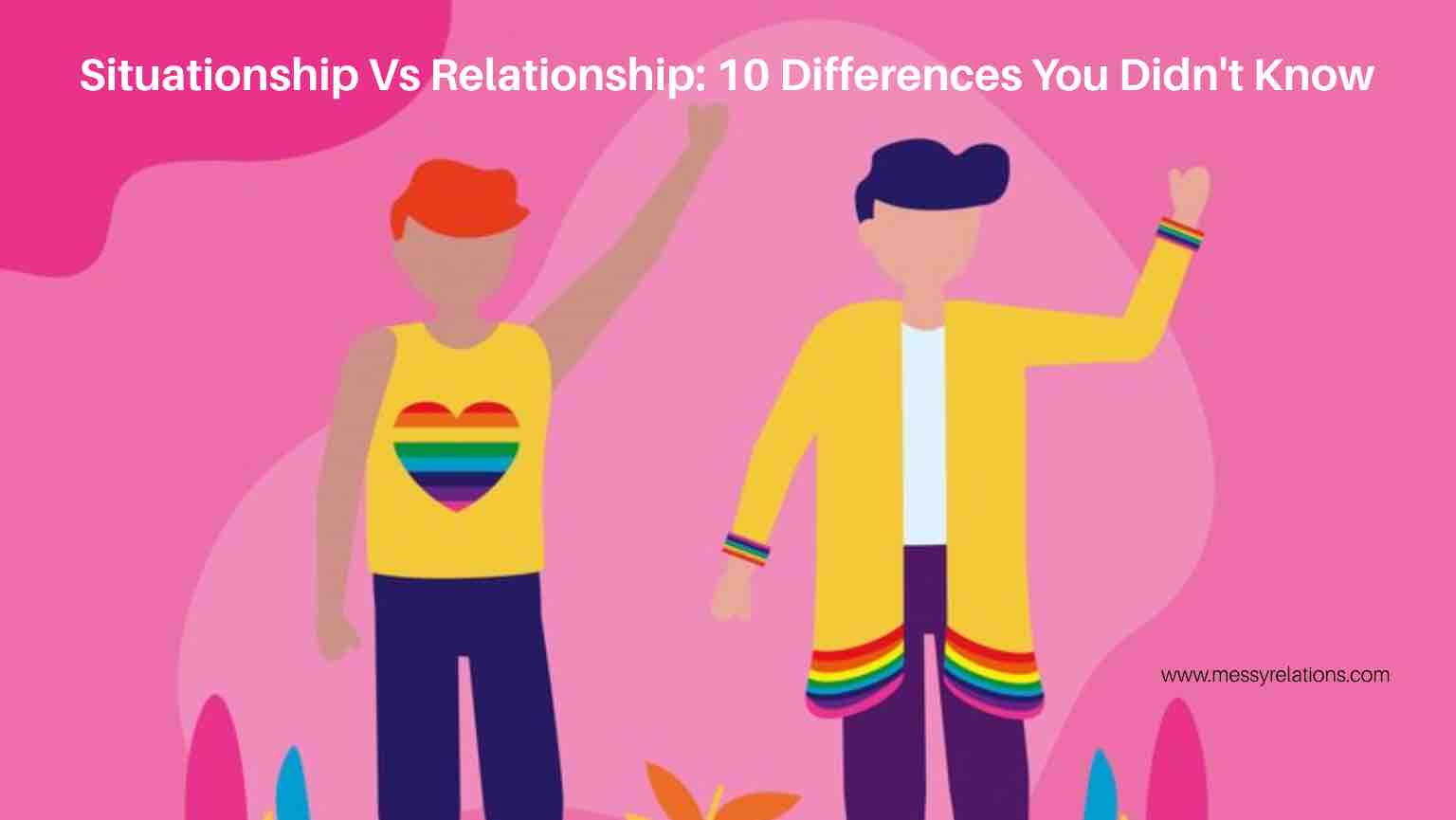The complex world of modern dating can sometimes feel like trying to decipher an ancient language. Two terms that frequently pop up are “situationship” and “relationship.” While they may seem similar at first glance, there are key distinctions that set them apart. In this article, we’ll explore the situationship and relationship difference, shedding light on 10 aspects you might not have considered before.
What is Situationship and Relationship?
Before we dive into the differences, let’s clarify what we mean by these terms. A “relationship” typically refers to a committed, defined partnership between two individuals. On the other hand, a “situationship” is a more ambiguous connection, lacking clear definition or commitment.
1. Commitment Level
Relationship: A Clear Commitment
In a relationship, commitment is the bedrock. Both parties have usually had a discussion about their status and have agreed to be exclusive, or at least have set clear boundaries and expectations. This commitment provides a sense of security and stability within the partnership.
Situationship: Ambiguity Reigns
Conversely, a situationship thrives on ambiguity. There’s often no explicit commitment or discussion about the future, leaving both individuals in a state of uncertainty. This can lead to confusion and insecurity, as neither party is entirely sure where they stand.
2. Emotional Investment
Relationship: Deep Emotional Connections
Relationships are characterized by a deep emotional connection and vulnerability. Partners in a relationship are typically open with their feelings, fears, and hopes for the future.
Situationship: Emotional Guardedness
In situationships, emotional investment is usually more guarded. Individuals might hold back from fully expressing their feelings due to the uncertainty of the connection.
3. Future Planning
Relationship: Building a Future Together
Couples in a relationship often make plans for the future, whether that’s moving in together, planning vacations, or discussing long-term goals. This forward-thinking is a sign of a committed partnership.
Situationship: Living in the Moment
Situationships, on the other hand, tend to focus on the present. Future planning is minimal or non-existent, as the connection’s longevity remains uncertain.
4. Communication Patterns
Relationship: Open and Consistent
Communication in a relationship is typically open, honest, and consistent. Partners feel comfortable discussing a wide range of topics, from daily trivialities to more serious issues.
Situationship: Sporadic and Surface-Level
In a situationship, communication might be more sporadic and tend to focus on surface-level topics. Deep, meaningful conversations about feelings or the relationship’s status are often avoided.
5. Social Integration
Relationship: Integrated Lives
In a relationship, partners often integrate their lives. This includes meeting each other’s friends and family, attending social events together, and becoming a part of each other’s social circles.
Situationship: Separate Social Spheres
Situationships usually maintain separate social spheres. There’s less emphasis on meeting friends or family, keeping the connection more private and detached from other areas of life.
6. Public Acknowledgment
Relationship: Public Recognition
Couples in a relationship typically acknowledge their partnership publicly, whether through social media, within their social circles, or in public settings.
Situationship: Keeping It Under Wraps
Situationships often lack public acknowledgment. The connection might be kept a secret or simply not discussed openly, adding to its undefined nature.
7. Conflict Resolution
Relationship: Working Through Issues
In relationships, conflicts are generally addressed and resolved through communication. There’s a willingness to work through issues for the sake of the partnership.
Situationship: Avoidance or Endgame
Conflicts in situationships can lead to avoidance or even the end of the connection, as there’s less of a foundation to motivate resolution efforts.
8. Support Systems
Relationship: Emotional and Practical Support
Relationships provide a strong support system, offering both emotional and practical support during challenging times.
Situationship: Limited Support
The support offered in a situationship can be more limited, often confined to the parameters of the connection and less involved with personal or emotional challenges.
9. Boundaries and Expectations
Relationship: Clearly Defined
In a relationship, boundaries and expectations are typically discussed and respected, helping to ensure that both partners’ needs are met.
Situationship: Unclear and Fluid
Boundaries and expectations in a situationship can be fluid and unclear, leading to misunderstandings and frustrations.
10. Personal Growth and Development
Relationship: Mutual Growth
Relationships often foster personal growth and development, with partners supporting each other’s goals and aspirations.
Situationship: Individual Paths
In situationships, personal growth tends to remain individualistic, with less emphasis on mutual development or support.
Understanding the differences between a situationship and a relationship can help clarify your own connections and what you’re looking for in a partner. Whether you’re in a committed relationship or navigating the uncertain waters of a situationship, recognizing these distinctions can empower you to make informed decisions about your romantic life. Remember, the most important aspect is what you want and need from a connection, and ensuring those desires are communicated and respected.
How to Handle a Situationship?
Navigating the murky waters of a situationship can be a perplexing experience. Unlike traditional relationships, situationships lack clear boundaries, making it challenging to understand where you stand. If you find yourself in this undefined territory, fear not. This article aims to guide you through handling a situationship with grace and clarity.
Recognize the Nature of Your Connection
First and foremost, acknowledge that you are in a situationship. Understanding the nature of your connection is crucial. A situationship is characterized by its lack of clear definition, commitment, and often, an open discussion about the future. By recognizing this, you can set realistic expectations for yourself and the dynamics of your interaction.
Communicate Openly and Honestly
Communication is key in any form of relationship, and situationships are no exception. It’s essential to have open and honest conversations about your feelings, expectations, and concerns. While this might seem daunting, especially in a setup that thrives on ambiguity, it’s crucial for your emotional well-being.
Set Personal Boundaries
Setting personal boundaries is vital. Determine what you are comfortable with and communicate these boundaries clearly. Whether it’s about how often you see each other, the level of emotional investment, or physical intimacy, knowing your limits helps maintain your sense of self-respect and prevents potential hurt.
Manage Your Expectations
In a situationship, managing your expectations is paramount. Since situationships lack the commitment and defined future of traditional relationships, it’s important to keep your expectations in check to avoid disappointment. Enjoy the connection for what it is, without imposing the expectations of a full-fledged relationship on it.
Prioritize Self-Care and Emotional Health
Situationships can be emotionally taxing. Prioritizing your self-care and emotional health is crucial. Engage in activities that bring you joy and fulfillment outside of your situationship. Maintaining a strong support system of friends and family can also provide emotional stability and perspective.
Know When to Walk Away
Understanding when to walk away from a situationship is crucial. If the arrangement no longer serves you, or if it becomes emotionally draining, it might be time to reevaluate. Trust your instincts and make decisions that prioritize your happiness and well-being.
Consider the Future
While situationships often focus on the present, it’s important to consider what you want in the future. Reflect on whether this situationship aligns with your long-term desires and goals. If there’s a misalignment, it may be time to reconsider your involvement.
Handling Uncertainty
The uncertainty of a situationship can be its most challenging aspect. Learning to navigate this uncertainty without letting it dominate your emotional landscape is key. Finding peace in the present moment and detaching from the need for definitive answers can provide a sense of calm amidst the ambiguity.
Embrace Personal Growth
Every interpersonal dynamic offers an opportunity for personal growth. Use your situationship as a chance to learn more about yourself, your needs, and how you handle ambiguous situations. This self-awareness can be invaluable in all areas of your life.
Seek Support When Needed
Lastly, don’t hesitate to seek support. Whether it’s from friends, family, or a professional, talking about your experiences and feelings can provide clarity, validation, and guidance. Remember, you’re not alone in navigating the complexities of modern dating dynamics.
Handling a situationship requires a balance of open communication, self-awareness, and emotional resilience. By understanding the nature of your connection, setting clear boundaries, and prioritizing your well-being, you can navigate this ambiguous terrain with confidence and clarity.
How to Handle a Relationship?
Being in a relationship can be one of the most rewarding experiences, offering companionship, love, and support. However, maintaining a healthy relationship requires effort, understanding, and communication from both partners. Here’s how to handle a relationship effectively, fostering a strong, lasting bond.
Communication is Key
Open, honest communication is the cornerstone of any healthy relationship. It’s essential to express your feelings, desires, and concerns openly and respectfully. Regular check-ins can help ensure that both partners are on the same page and address any issues before they escalate.
Practice Active Listening
Listening is just as important as sharing your thoughts. Practice active listening by paying full attention to your partner, acknowledging their feelings, and responding empathetically. This fosters a deeper understanding and connection.
Show Appreciation and Gratitude
Expressing appreciation and gratitude for your partner can significantly strengthen your bond. Simple gestures, kind words, and acknowledgment of each other’s efforts can go a long way in maintaining a positive atmosphere.
Maintain Trust and Honesty
Trust and honesty are the foundation of a strong relationship. Be truthful and transparent with your partner, and ensure that you’re both committed to maintaining trustworthiness in your actions and words.
Respect Each Other’s Independence
While a relationship involves sharing your lives, it’s crucial to respect each other’s independence. Encourage and support each other’s interests, hobbies, and friendships outside the relationship. This balance enhances personal growth and the health of the relationship.
Resolve Conflicts Constructively
Conflicts are inevitable in any relationship, but it’s how you handle them that matters. Approach conflicts with a problem-solving attitude, focusing on finding a solution rather than winning the argument. Practice empathy, compromise, and patience.
Keep the Romance Alive
Maintaining the spark in a relationship requires effort. Regular date nights, surprises, and intimate moments can keep the romance alive. It’s important to prioritize your connection and make time for each other amidst life’s responsibilities.
Support Each Other’s Goals
A strong relationship involves mutual support for each other’s personal and professional goals. Encourage your partner’s ambitions and celebrate their achievements, fostering a supportive and uplifting environment.
Practice Forgiveness
Forgiveness is essential in a relationship. Holding onto grudges can lead to resentment and bitterness. While it’s important to address issues, learning to forgive and move forward strengthens your bond.
Invest in Shared Experiences
Creating shared experiences, whether it’s through travel, hobbies, or shared goals, can deepen your connection. These shared memories become the fabric of your relationship, enriching your bond.
Handling a relationship involves a continuous effort to communicate effectively, show appreciation, maintain trust, and support each other. By investing in your partnership and navigating challenges together, you can build a fulfilling and enduring relationship.
Situationship or Relationship – Which is Better?
The question of which is better—situationship or relationship—does not have a one-size-fits-all answer. It depends on individual needs, life circumstances, and what each person seeks in their romantic connections.
For those valuing freedom, flexibility, and a lighter emotional investment, situationships might offer the perfect balance. They provide the intimacy and connection of a romantic partnership without the weight of commitments and expectations.
For others craving depth, stability, and long-term companionship, relationships offer a foundation of commitment and emotional investment that can lead to profound personal growth and fulfillment.
Ultimately, the key is self-awareness and communication. Understanding what you truly want and need from a romantic connection, and communicating those desires clearly, is crucial. Whether it’s the freedom of a situationship or the depth of a relationship, choosing the path that aligns with your personal values and life goals is what determines which is better for you.




